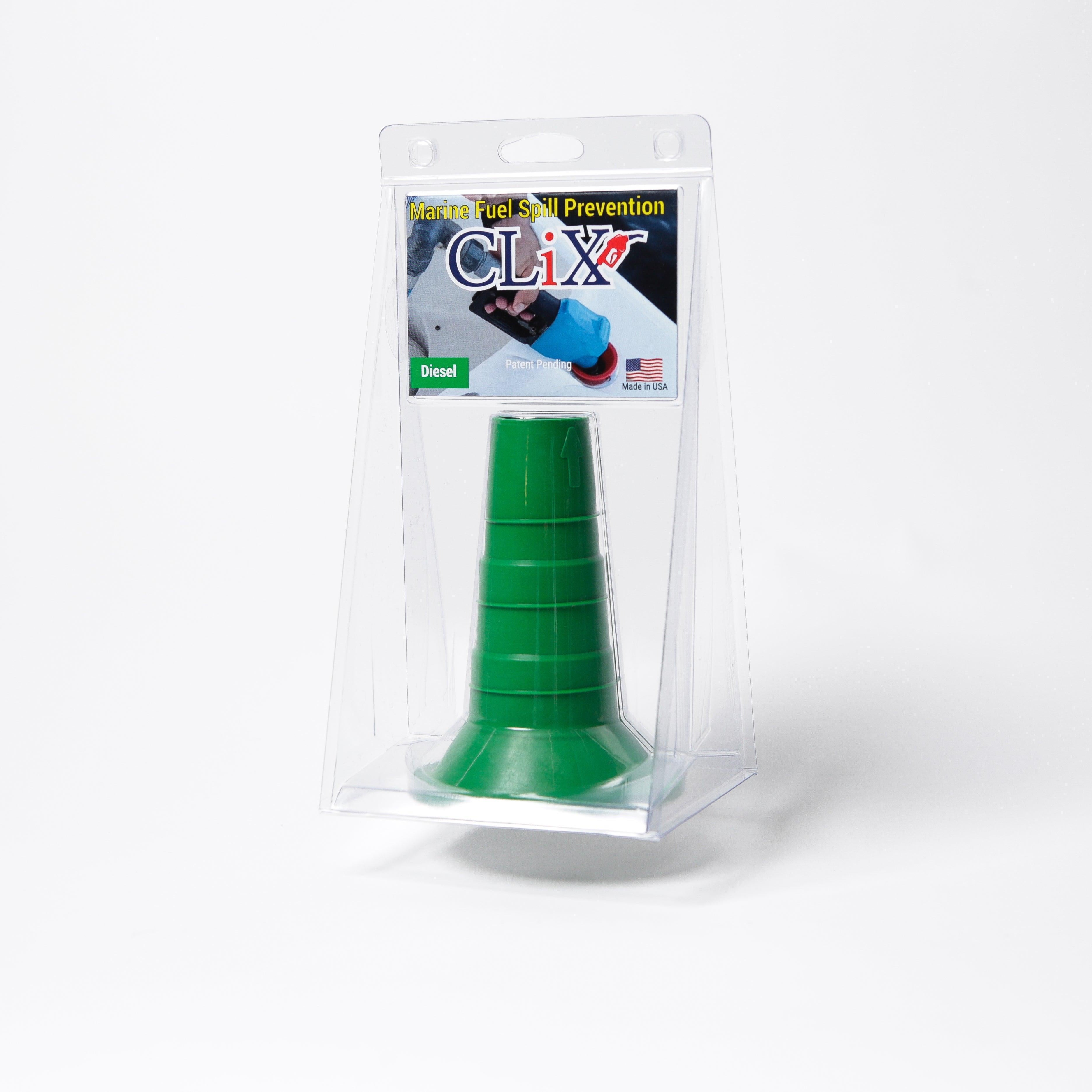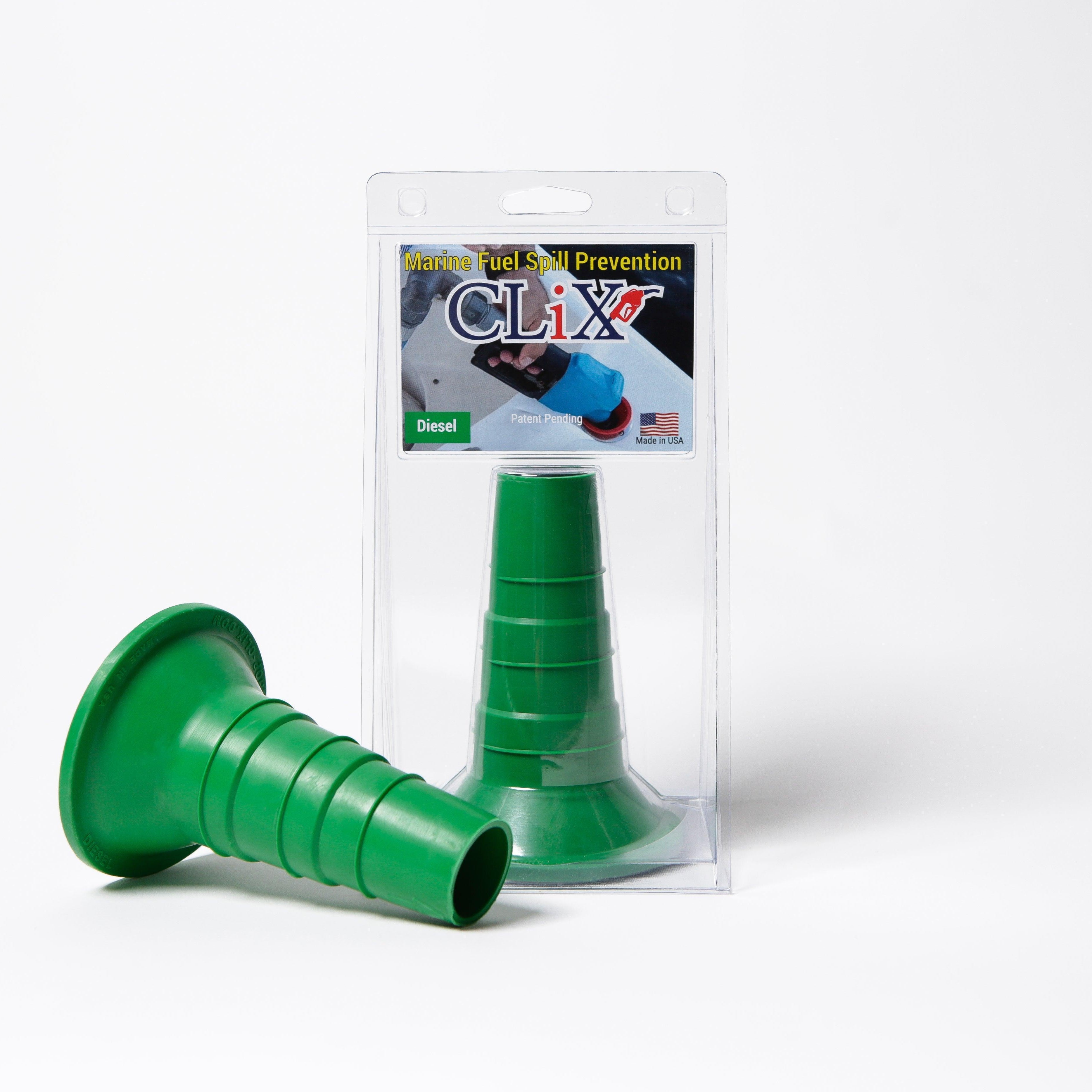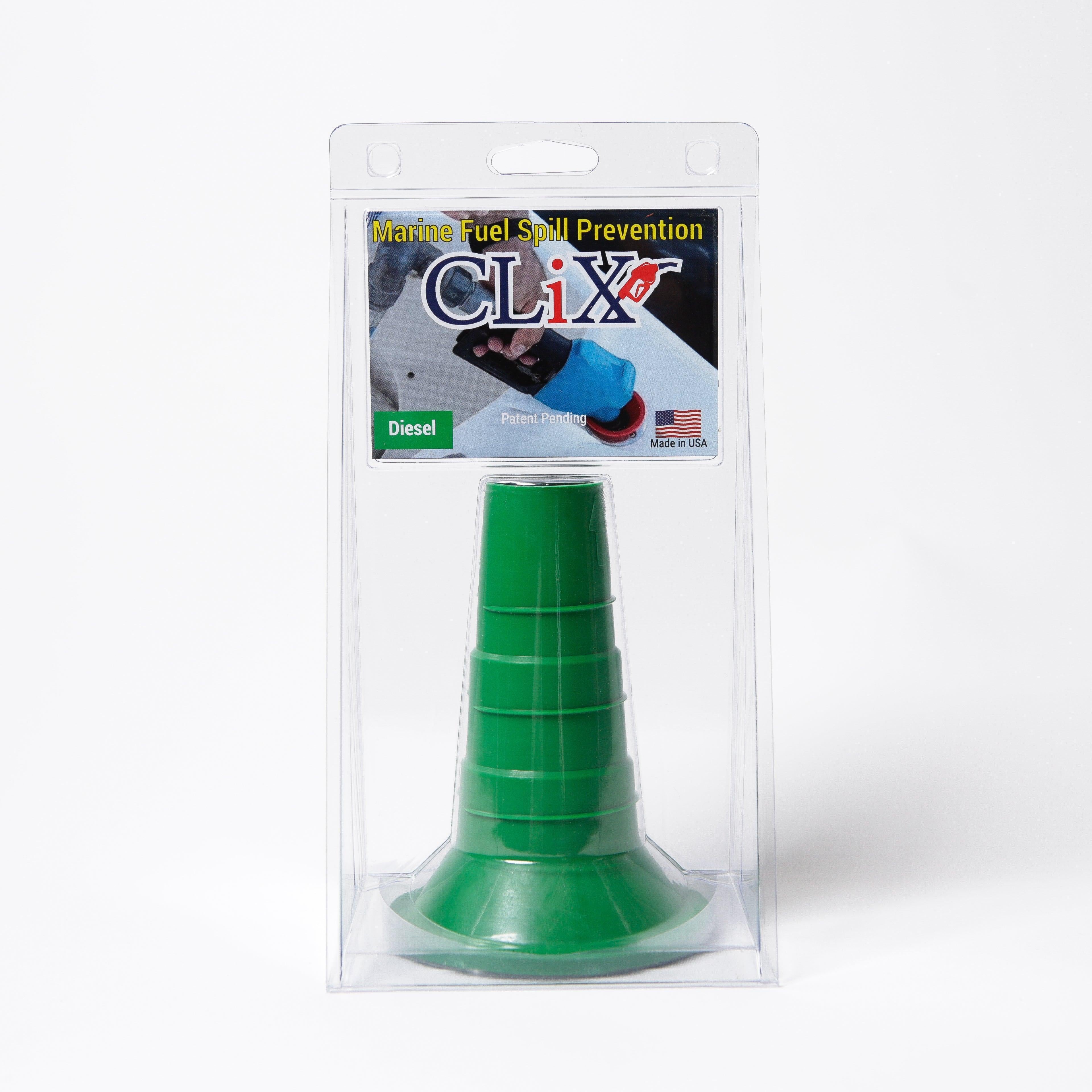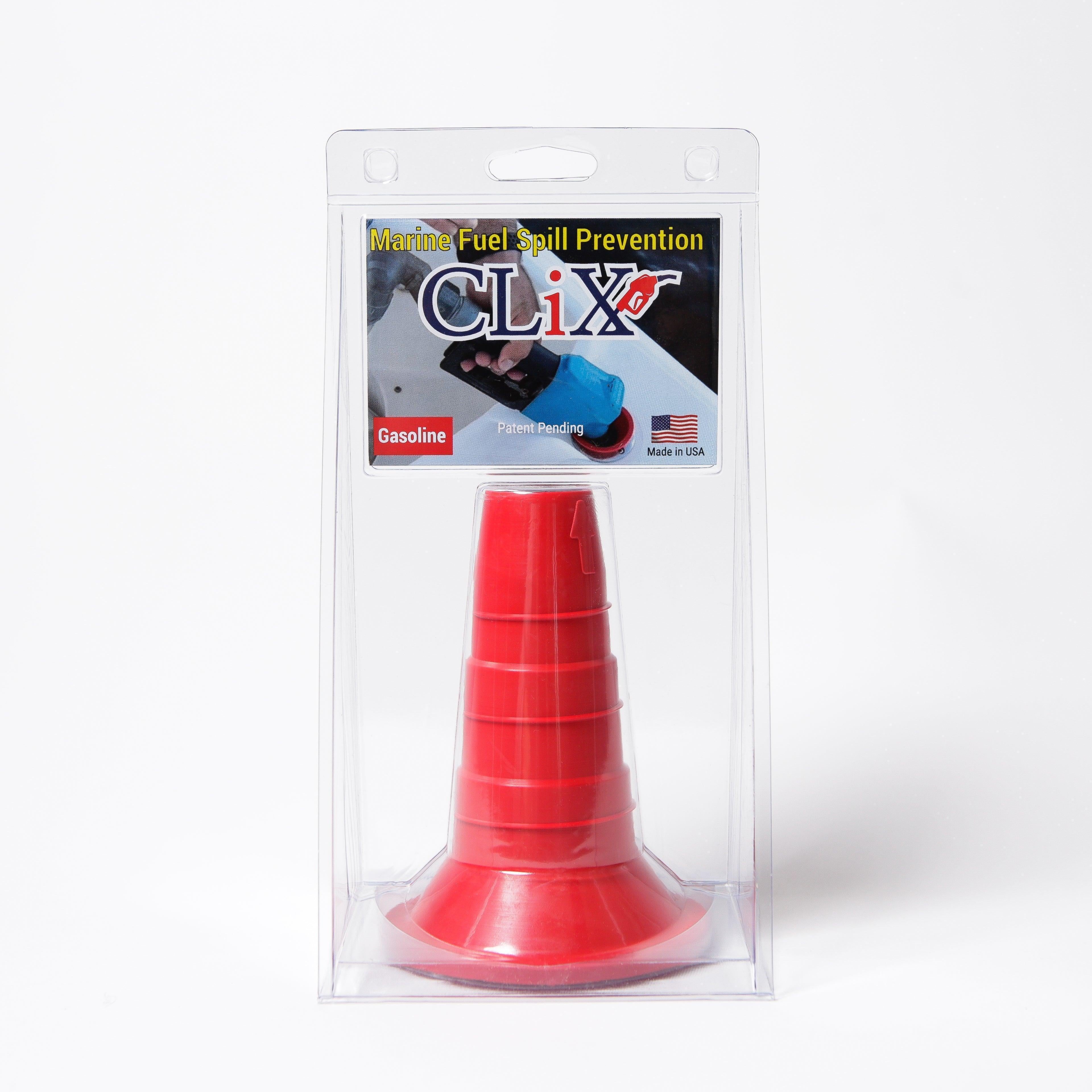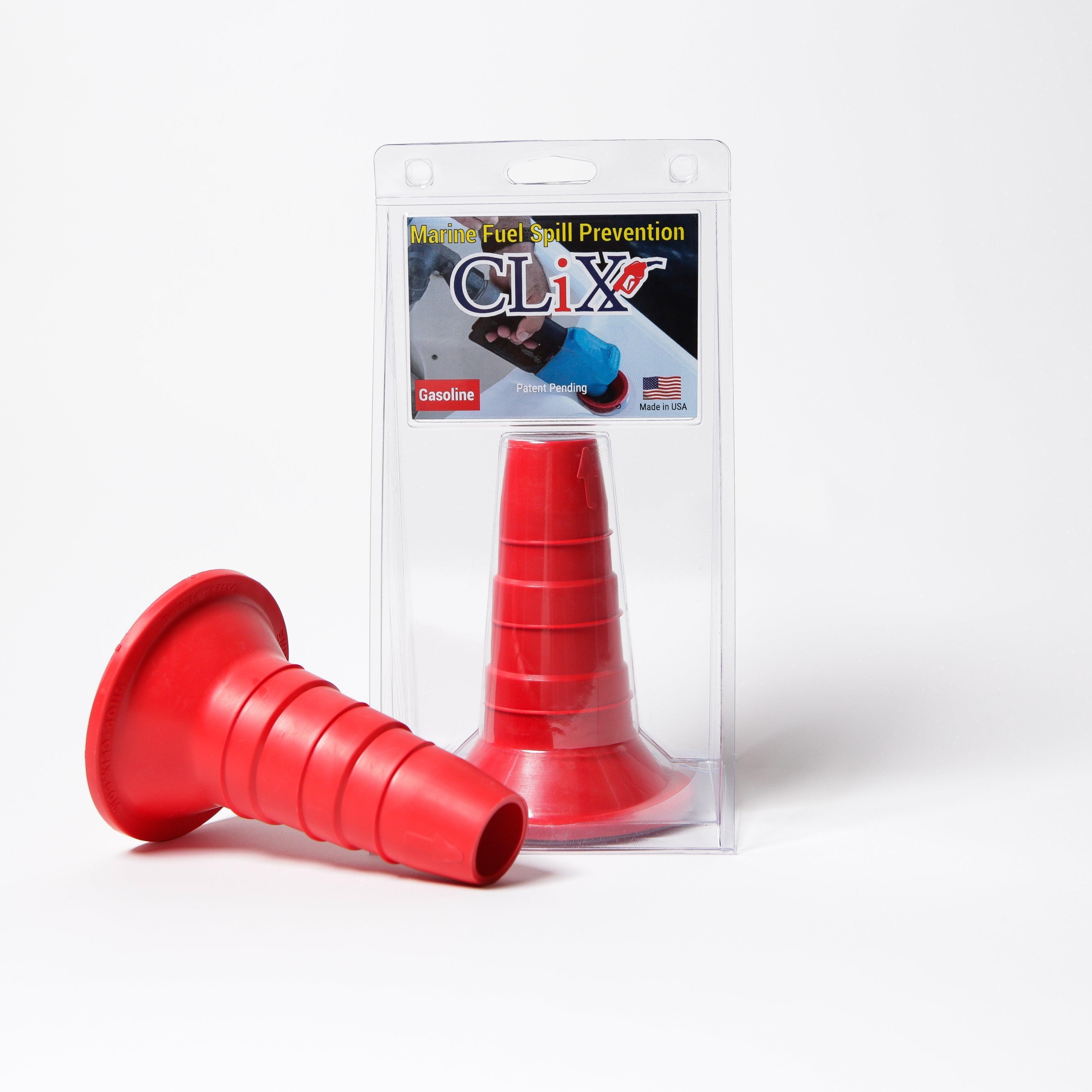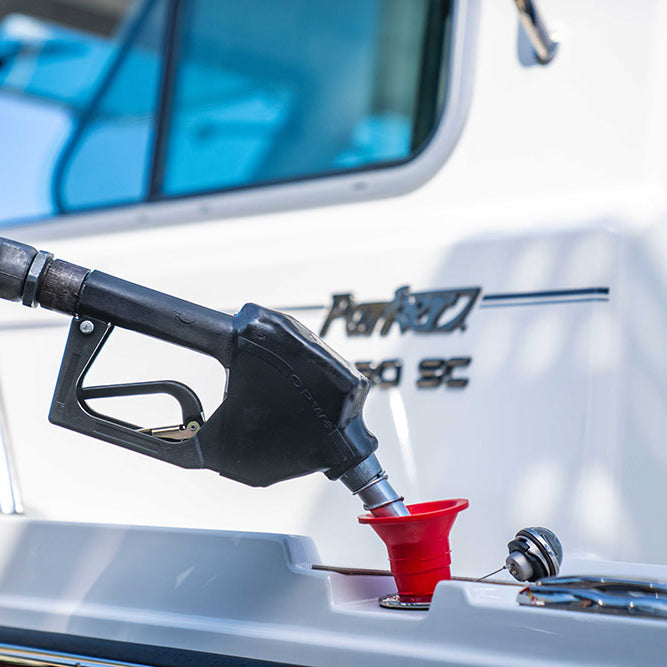A marine fuel vent is a small but absolutely essential safety device that lets your boat's fuel tank "breathe." It's designed to prevent a dangerous buildup of pressure or a vacuum inside the tank by allowing air to flow in and out. This simple function is key to protecting your engine, preventing fuel spills, and ensuring safe operation.
Why Your Boat's Fuel Tank Needs to Breathe
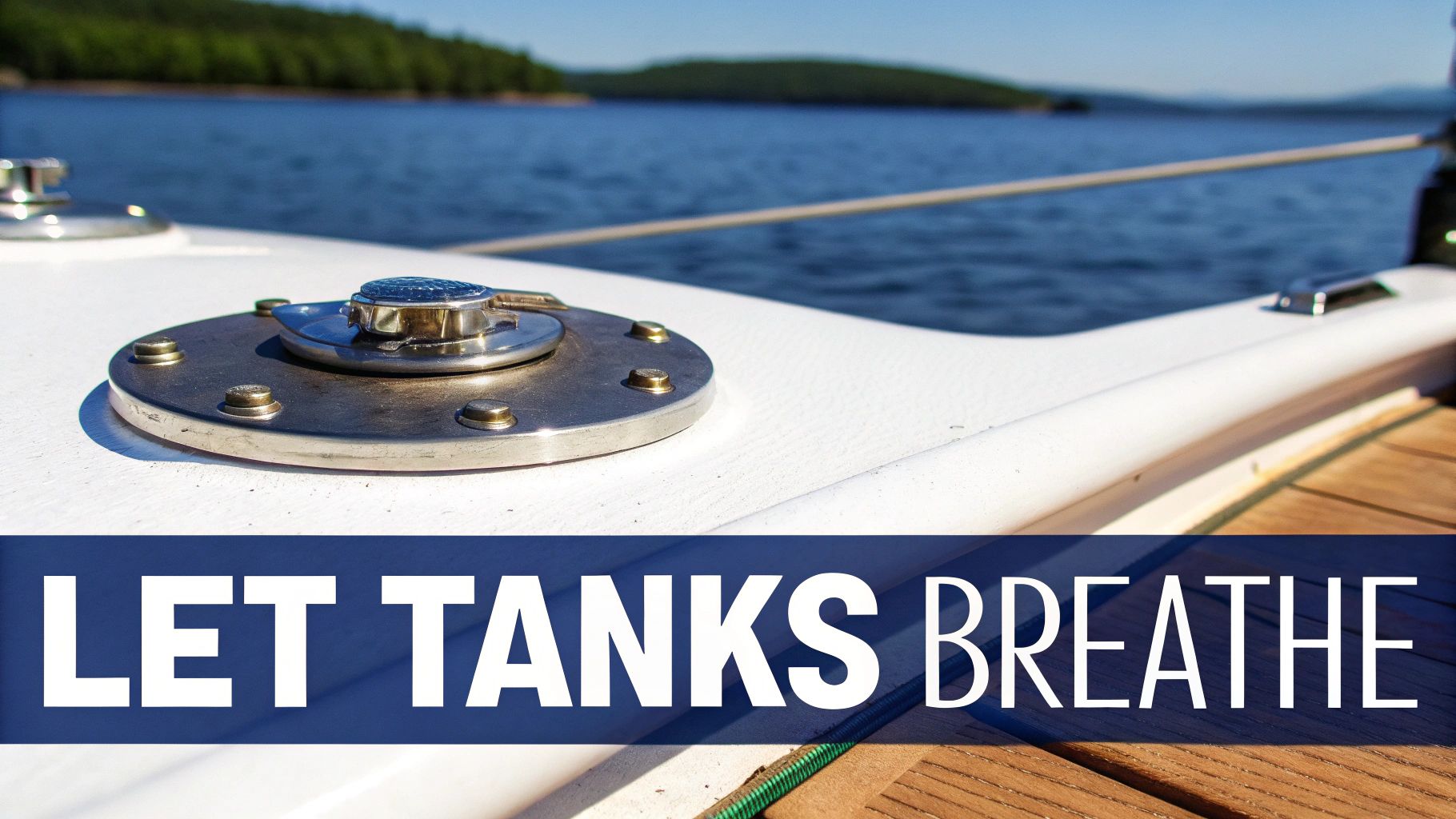
Imagine your boat's fuel tank is just a sealed can. Without a vent, two big problems are waiting to happen. As your engine runs and pulls fuel out, it starts creating a vacuum. This negative pressure works against the fuel pump, which can starve the engine of fuel and cause it to sputter or stall—usually at the worst possible moment.
In a serious case, a powerful vacuum can even make a plastic or aluminum tank buckle or collapse. A marine fuel vent fixes this by letting replacement air flow into the tank, which keeps the pressure equalized and ensures your engine gets a steady, reliable supply of fuel.
Handling Pressure and Stopping Spills
The opposite issue happens when your boat is just sitting out in the sun. The fuel inside heats up and expands, creating vapor and building positive pressure. This pressure can strain the tank's seams, force fuel into places it shouldn't be, and create a serious fire hazard.
A good fuel vent gives that expanding air and vapor a safe way to escape. It releases the pressure long before it becomes dangerous, protecting the entire fuel system. Modern vents are designed to let the air out without spilling a single drop of fuel.
A clogged or faulty fuel vent is one of the most common—and overlooked—causes of engine problems and refueling headaches. If you hear a "whoosh" when you open the fuel cap or get fuel spitting back at you during fill-ups, you've likely got a vent issue.
The Unsung Hero of Your Fuel System
When you get right down to it, the fuel vent is the unsung hero that keeps your boat safe and reliable. It’s a simple part, but its job of managing airflow affects several critical systems:
- Engine Performance: It ensures a steady, uninterrupted flow of fuel by preventing vacuum lock.
- System Integrity: It protects the tank and hoses from the physical stress of extreme pressure or vacuum.
- Easy Refueling: A clear vent lets air escape as you fill up, preventing that messy and dangerous fuel splash-back.
- Environmental Protection: By preventing spills, a properly working vent helps keep our waterways clean.
Getting to know the parts of your boat is crucial for any owner, and you can learn more about the different kinds of boat fuel tanks in our detailed guide: https://clixfueling.com/blogs/news/boat-fuel-tanks. Taking care of this small component isn't just a suggestion—it's a fundamental part of safe boating.
How a Marine Fuel Vent Really Works
Think of your boat's fuel tank not as a simple container, but as a living, breathing part of the vessel. The marine fuel vent is what allows it to "breathe." It’s basically a two-way street for air, letting it in or out to keep the pressure inside the tank perfectly balanced with the world outside.
This balancing act is crucial and handles two opposite but equally important jobs: letting air in to prevent a vacuum, and letting air out to release pressure. Get either one wrong, and you’re looking at serious—and often misdiagnosed—problems that can ruin a day on the water.
Letting Air In When the Engine is Running
When your engine is running, it's constantly sipping fuel from the tank. As the fuel level drops, something has to fill that empty space. If it doesn't, a powerful vacuum forms inside the tank.
It's just like trying to drink from a juice box without a vent hole. After a few sips, the box starts to collapse, and pulling any more juice out becomes a real struggle. Your fuel tank is no different. Without a vent allowing air to enter, the vacuum will literally fight against the fuel pump.
This can cause all sorts of headaches that might have you chasing the wrong problem:
- Engine Sputtering or Stalling: The fuel pump can't overcome the vacuum, starving the engine of fuel and causing it to run rough or cut out entirely.
- Loss of Power: Even if the engine keeps running, it might feel sluggish and weak, especially when you need the power most.
- Fuel Pump Damage: Making the pump constantly work against that vacuum is a recipe for premature burnout and failure.
A good, clear vent lets air flow into the tank effortlessly, replacing every drop of fuel used. This ensures your engine gets the steady, uninterrupted supply it needs to run like a top.
Letting Pressure Out When Things Heat Up
The opposite problem pops up when your boat is sitting still, especially on a hot day. Fuel expands with heat. As the temperature climbs, the gasoline or diesel in your tank not only increases in volume but also creates more flammable vapor. This one-two punch can build up a surprising amount of pressure inside the tank.
If that pressure has nowhere to go, it can start pushing on the tank's seams and welds, which can lead to dangerous leaks. In a worst-case scenario, it could even warp or rupture the tank. Even more frightening, that pressure can force explosive fuel vapors into your bilge, creating a ticking time bomb.
A properly installed marine fuel vent is your safety release valve. It gives that expanding air and vapor a safe path to escape long before the pressure builds to a dangerous level.
This is why you sometimes hear a hiss when you open the fuel cap on a hot day—that's pent-up pressure escaping. A little hiss is normal, but a loud, sustained "whoosh" is a red flag. It likely means your vent is partially clogged and isn't doing its job.
Whether it’s preventing a vacuum or releasing pressure, that humble marine fuel vent is one of the most critical safety components on your boat.
Choosing the Right Fuel Vent for Your Boat
Picking the right fuel vent for your boat isn’t as simple as grabbing the first one you see. Your boat, your fuel system, and even where you take it all play a role in what you need. Getting this choice right is a big deal for safety and performance, making sure your fuel system can breathe properly no matter what.
Most boats come with a standard through-hull vent, usually covered by a simple clamshell. They're the go-to for a reason: they're reliable, affordable, and a breeze to install. These vents create a straightforward path for air to move in and out, which stops a vacuum from forming as you use fuel and prevents pressure from building up on a hot day. Their biggest weakness? They’re just an open hole, which can let water in when the seas get rough.
Upgrading for Better Protection
If you’re looking for more than the basics, especially if you head offshore, there are some great upgrades that solve the problems of simpler vents. Think of them as an extra line of defense against water and fuel spills.
-
Pressure/Vacuum (P/V) Vents: Imagine a smart bouncer for your fuel tank. A P/V vent stays sealed tight until the pressure or vacuum inside the tank hits a specific point. This is fantastic for keeping water out in heavy spray or choppy waves while still letting the tank breathe exactly when it needs to.
-
Vents with Integrated Flame Arrestors: Safety on the water is everything. Vents with a built-in flame arrestor—a fine metal mesh screen—stop an external spark or flame from igniting the fuel vapors in your vent line. This is a must-have safety feature, particularly for gas-powered boats.
-
Fuel/Air Separators: These are special canisters you install in the vent line to prevent fuel from spewing overboard when you're filling up—a surprisingly common source of water pollution. As the tank gets full, any fuel that sloshes up the vent line gets trapped and drains back into the tank, letting only clean air out.
One thing that’s really changed the game is the global shift to low-sulfur fuels. These modern fuels behave differently, and our venting systems have had to adapt. Vents now need to handle fuels with different volatility, making advanced systems like P/V valves more critical for safe operation than ever before. You can read more about how modern bunker fuels are impacting the industry on PR Newswire.
Comparing Materials and Designs
The material your fuel vent is made of really matters. It affects how long it will last and how good it looks years down the line. The two main players here are stainless steel and chrome-plated zinc, and they each have their pros and cons.
Stainless steel is the top-shelf option. It offers incredible resistance to corrosion, especially in saltwater, and will look great for years with almost no effort. It costs more upfront, but its sheer durability often makes it the cheaper choice in the long run.
Chrome-plated zinc is easier on the wallet. It can look sharp when it's new, but it's prone to pitting and corrosion over time, especially once that chrome finish gets scratched. It's a fine choice for freshwater boating, but if you're in the salt, you should really consider spending a bit more for stainless.
A Quick Comparison to Help You Choose
To make things a little clearer, here’s a look at the common types of marine fuel vents side-by-side. This should help you zero in on the best fit for your boat and your needs.
Comparison of Marine Fuel Vent Types
| Vent Type | Key Feature | Primary Advantage | Potential Disadvantage | Best For |
|---|---|---|---|---|
| Standard Through-Hull | Simple open-path design | Cost-effective and reliable | Susceptible to water intrusion | Smaller boats, calm water conditions |
| Pressure/Vacuum (P/V) | Spring-loaded valve | Excellent water protection | More complex and expensive | Offshore boats, rough conditions |
| Vent with Flame Arrestor | Integrated mesh screen | Prevents ignition of fuel vapors | Screen can become clogged | All gasoline-powered boats (essential) |
| Fuel/Air Separator | In-line canister | Prevents fuel spills during refueling | Adds complexity to installation | Environmentally-conscious boaters |
Ultimately, the best vent is the one that matches your boat, your budget, and the kind of boating you do.
Making the Right Decision for Your Vessel
So, how do you choose the best marine fuel vent? It really boils down to your specific situation. Ask yourself these three simple questions to find your answer:
- Where do you boat? If you’re often in rough seas or dealing with a lot of spray, a P/V valve or a well-designed vent is a must to keep water out of your fuel.
- What’s your top priority? If safety is number one, a vent with a flame arrestor isn't optional. If you’re focused on protecting the environment, a fuel/air separator is a smart upgrade.
- What’s your budget? A basic vent is cheap, but spending a bit more on a high-quality stainless steel P/V valve now can save you from the massive headache and cost of a tank full of contaminated fuel later on.
By thinking through these points, you can pick a fuel vent that goes beyond the bare minimum and actually improves the safety, reliability, and eco-friendliness of your boat.
Proper Installation to Avoid Common Failures
Picking out the right marine fuel vent is just the start. Even the best vent on the market will cause you headaches if it's not installed correctly. In fact, a top-shelf vent with a botched installation is far more dangerous than a basic one put in the right way.
Getting the installation right is your final, and most important, step to a safe and reliable fuel system. It’s what stands between you and problems like water in your fuel, dangerous fumes building up, or vacuum locks that starve your engine.
This flowchart walks you through how to choose the right vent for your boat, from the standard options to more specialized ones.

As you can see, there’s a clear path to follow, helping you match a vent to your boat’s specific needs for both safety and performance.
Location, Location, Location
Where you decide to mount the fuel vent is probably the single most important call you'll make. The sweet spot is a location that does three things at once: keeps water out, keeps fumes away from people, and keeps the vent itself safe from getting knocked around.
Here are the rules of thumb you can't ignore:
- High and Dry: Mount the vent as high up on the hull as you possibly can. This simple step dramatically cuts down the risk of it dipping underwater in rough seas, which would be like putting a firehose directly into your fuel tank.
- Clear of Cabins: Keep that vent far away from any windows, portholes, hatches, or engine air intakes. Fuel vapors are heavier than air and will sink into low spots, creating a huge fire hazard if they get inside the boat.
- Face the Stern: Whenever you can, point the vent's opening toward the back of the boat. This prevents air and spray from being forced down the line when you're moving.
The All-Important Anti-Siphon Loop
Once you’ve found the perfect spot, how you run the hose is the next make-or-break detail. The most effective way to keep water out of your tank through the vent line is by creating an anti-siphon loop.
Think of an anti-siphon loop as a high arch in the hose. You run the hose up from the tank, well above the vent fitting on the hull, and then down to the vent itself. This loop is a simple but brilliant physical barrier.
Picture a big wave washing over the side. Without that loop, water has a straight shot right into your fuel. But with a high loop, gravity becomes your best friend, forcing any water that gets in to drain right back out.
Using the Right Gear and Connections
Your whole fuel vent system is only as strong as its weakest link. This is not the place to cut corners. A fuel leak or vapor buildup is a risk nobody should take.
1. Get the Right Hose: Only use hose that is specifically rated for fuel vents, like SAE J1527 Type A2. This stuff is built to handle gasoline, diesel, and ethanol blends without getting brittle, cracking, or letting vapors seep through.
2. Make Solid Connections: Use good, marine-grade stainless steel hose clamps on both ends—at the vent and at the tank. Double-clamping is always a smart move for an extra layer of security.
3. Seal It Up Tight: When you mount the through-hull vent fitting, bed it in a quality marine sealant like 3M 5200. This creates a tough, waterproof seal that keeps water from getting into your hull's core around the hole you drilled.
If you want an extra layer of defense against fuel sloshing up the vent line when you’re refueling or bouncing around in heavy seas, you can add an in-line device. Check out this fuel vent line surge protector which is designed to stop that exact problem.
Keeping Your Fuel Vent Breathing: Maintenance and Troubleshooting

A working fuel vent is one of those things you never think about—until it stops working. A clogged vent can cause all sorts of headaches that look a lot like serious engine trouble, from sputtering to stalling out completely.
Think of your fuel tank like a soda bottle. As you pour fuel out (or the engine draws it in), air needs to get in to replace it. If the vent is blocked, a vacuum forms, and the fuel pump simply can't pull any more fuel. A few minutes of preventative maintenance can save you a world of frustration and potentially costly, unnecessary repairs.
Your Routine Maintenance Checklist
Making a quick vent check part of your regular routine is one of the smartest things a boat owner can do. It’s simple, fast, and can prevent a bad day on the water.
Here’s a quick rundown of what to look for:
- The Outside Vent: Start with a visual check of the vent fitting on your hull. It’s a favorite spot for mud daubers, spiders, and crystallized salt to build a home. Clear away any visible gunk.
- The Screen: Most vents have a small screen that acts as a flame arrestor. This is the #1 culprit for clogs. If you can, carefully remove the fitting and give the screen a good cleaning with a soft brush.
- The Hose: Follow the vent hose from the hull fitting all the way back to the tank. You're looking for kinks, cracks, or any low spots where water or fuel could get trapped and create a blockage. A sagging or degraded hose is just as bad as a bug nest.
A clean fuel vent isn’t just about keeping your engine running right. It’s also about efficiency and being a good steward of the environment. A properly breathing system prevents fuel from expanding and pushing out of the vent, which reduces waste and harmful vapor emissions.
This focus on efficiency is a huge deal in the marine world. In fact, the global marine fuel optimization market was valued at around $12.01 billion in 2024, and it's built on getting the most out of every drop of fuel. Smart components like well-designed vents are a key part of that puzzle. You can read more about the financial side of fuel efficiency at The Business Research Company.
Spotting the Signs of a Blocked Vent
Your boat will usually give you some pretty clear signals when its fuel vent is suffocating. If you know what to listen for, you can diagnose the problem in seconds.
Keep an eye (and ear) out for these classic symptoms:
- The Engine Stalls Under Load: Does your engine idle just fine at the dock but starts to sputter or die completely when you throttle up? That’s a tell-tale sign of fuel starvation caused by a vacuum.
- The 'Whoosh' of Death: When you open your fuel cap, do you hear a loud, sucking sound? That's the vacuum in your tank being released. It's a dead giveaway that your vent is clogged.
- Splash-Back at the Pump: If fuel keeps burping back at you when you're filling up, it’s because the air in the tank has no way to escape as the fuel goes in.
A Step-by-Step Guide to Clearing a Clog
If you suspect a blockage, there’s a safe and methodical way to track it down. A word of caution: never use high-pressure air to blow out a vent line while it's still attached to the tank—you could easily damage or even rupture the tank.
- Disconnect the Hose at the Hull: Start by carefully detaching the vent hose from the back of the through-hull fitting.
- Test the Fitting: Try blowing through the fitting from the inside. If it’s blocked, the clog is right there at the outlet or screen. Use a piece of stiff wire or a small pick to gently clean it out from the outside.
- Test the Hose: If the fitting was clear, the problem is in the hose itself. Disconnect the other end from the tank and blow through it. If it’s blocked, a shot of low-pressure compressed air might clear it. If the hose looks old, brittle, or kinked, just replace it—it’s cheap insurance.
Environmental Impact and Boating Regulations
That little fuel vent on your boat does a lot more than just let your tank breathe. It's actually a critical piece of gear for protecting the marine environment we all love.
Think about it: every time a little bit of fuel "burps" out of a vent during refueling, it goes straight into the water. It might seem like just a few drops, but when you multiply that by thousands of boats at the marina, it adds up to a serious pollution problem.
Modern venting systems are designed to put a stop to this. When you pair a marine fuel vent with a good fuel/air separator, you create a closed loop. Air can still escape as you fill the tank, but any fuel that gets pushed up the line gets captured and sent right back down. It's a simple, brilliant solution that prevents fuel discharge and keeps our waterways clean.
Complying with Clean Air and Water Rules
It's not just about preventing spills you can see. Your fuel system also has to control invisible emissions—the fuel vapor that escapes into the atmosphere. Regulatory bodies like the U.S. Environmental Protection Agency (EPA) have set firm rules to cut down on these evaporative emissions, which contribute to smog and air pollution.
To meet these standards, new boats need specific fuel system components, like carbon canisters and specially designed vents that trap and manage vapor. Getting your head around these regulations isn't just about avoiding a hefty fine; it’s a core part of being a responsible boater. Staying up-to-date is easier than you think, and our guide to environmental compliance training is a great place to start.
This isn't just a local issue, either. It’s part of a worldwide push for cleaner boating. The global marine fuel supply system has been reshaped by the demand for more efficient and environmentally friendly fuel handling. Organizations like the International Maritime Organization (IMO) have been leading the charge, setting tough standards for fuel venting to cut down on pollution and boost safety. A great example is the IMO’s 2020 sulfur cap, which pushed the industry toward new fuels that demanded smarter venting solutions.
Choosing a compliant and high-quality fuel venting system is a direct investment in the health of our lakes, rivers, and oceans. It’s a small choice on your boat that makes a big collective difference.
At the end of the day, a well-designed fuel vent marine system is a win-win. It keeps your boat running safely and smoothly while also protecting the very environment you're out there to enjoy. By understanding the rules and choosing the right equipment, you're doing your part to keep our waters pristine for the next generation.
Your Top Fuel Vent Questions Answered
Even when you think you've got the hang of how a fuel vent marine system works, a few specific questions always seem to pop up. Let's tackle some of the most common ones we hear from fellow boaters.
How Can I Tell If My Fuel Vent Is Clogged?
Your boat is pretty good at telling you when something's wrong, and a blocked vent is no exception. Watch out for these classic signs:
- Engine Sputtering: If your engine stalls or sputters when you hit the throttle, it might be starving for fuel because a vacuum is forming in the tank.
- A "Whoosh" at the Fuel Cap: Do you hear a loud hissing or sucking sound when you open your fuel cap? That's the sound of air rushing in to equalize the pressure, a dead giveaway of a vacuum.
- Fuel Splashback: If fuel constantly burps back at you while you're filling up, it's a strong sign that the air inside the tank has no other way to get out.
What Kind of Hose Should I Use for a Vent Line?
This is one area where you can't cut corners. You absolutely must use a hose that's specifically rated for fuel and approved by the U.S. Coast Guard.
Look for a hose clearly labeled SAE J1527. This certification means it’s built to handle gasoline and diesel without breaking down, cracking, or letting dangerous fumes escape. Grabbing a standard water hose is a huge mistake—fuel will eat right through it, creating leaks and a major fire risk.
A good rule of thumb for placing your vent is to go as high and as far outboard as you possibly can. This simple trick helps keep seawater out in rough seas and directs any fumes away from where people are.
What Happens If I Run My Boat with a Blocked Vent?
Running your boat with a clogged fuel vent can lead to some serious headaches. In a best-case scenario, you're dealing with an engine that stalls and loses power, which is frustrating enough.
But the worst-case scenario is much more serious. The intense vacuum created by the fuel pump can actually collapse or crack your fuel tank. It also turns refueling into a hazardous guessing game, making dangerous fuel spills far more likely.
A preventable fuel spill shouldn't be what ruins a perfect day on the water or harms the environment. CLiX Fueling Solutions has developed an automatic shut-off system that makes overfills a problem of the past. To make sure your next refueling is safe, clean, and completely stress-free, check out their solution at https://clixfueling.com.

